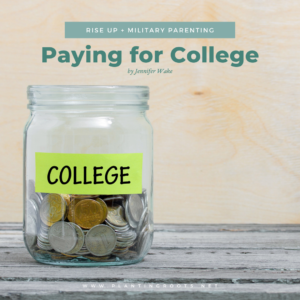
Jennifer discusses paying for college in this month’s Financial Friday post. Don’t miss part two, saving for college next month!
Paying for College
by Jennifer Wake
Wait a minute, just yesterday I had a baby, now I have a freshman in high school. Where did that time go? If you have a child in high school chances are they are starting to think about life after high school. Will they go to college and pursue a four year degree? Will they pursue an associate degree or a technical degree? Or will they join the military? Will they get a job right after high school?
If your child decides on college or higher education you will be faced with the decisions about how to pay for that education. If you had planned ahead you might have saved enough money to pay for college completely. Or you might have a wealthy relative willing to give your child all the money for college. If you are like most people, neither of these apply to you.
So what are your options for paying for college?
Most students will receive some form of financial aid. The amount and type of financial aid offered is based on two factors: the student’s merit (scholastic, athletic, musical, etc.) and the student’s financial need. To find out about student aid you can go directly to www.studentaid.ed.gov and they have a FAFSA4caster calculator which will help you answer financial questions. The financial aid a college gives a student can be in the form of scholarships or grants. You do not have to repay scholarships or grants unless the award stipulates that requirment. (If a student leaves an Academy early they may owe the government the cost of tuition and room and board.)
To find out about financial aid, you can go on savingsforcollege.com website and try their college cost calculator. It is close to what the government calculates. When your student is a senior you will be required to fill out a FAFSA form at www.fafsa.ed.gov. This form asks you many questions. You will need your current tax information, how much is in your savings accounts (excluding retirement accounts and any Coverdell ESA or 529 Student savings plans), how much is in your child’s savings accounts excluding ESA or 529 accounts, and the number of people in your family and your age (or your spouse’s age if they are older).
Once you fill out the forms you will receive your estimated amount of Expected Family Contribution (EFC). When your student decides on a college, you send your FAFSA form to that college (you can send it to multiple colleges). You must fill out a FAFSA form the year before your student enters college. You must do this between the fall of the previous year and June 30th of each college year.
Most colleges will encourage students to take out loans.
There are two types of loans, federal student loans and private student loans. The federal government backs federal student loans which have fixed interest rates. While federal student loans have strict eligibility requirements and borrowing limits, they traditionally offer several advantages over private loans. They can be subsidized (where the government pays the interest accruing while in college) or unsubsidized (where the interest accrues while in college and so the amount owed is higher when leaving college). Private student loans usually have higher fees and variable interest rates.
If you are currently in the military or a retiree you may be eligible for the post 9/11 GI bill. The Post-9/11 GI Bill pays for education and housing costs for military servicemembers and veterans who served at least 90 days of aggregate service on or after September 11, 2001, or who were discharged with a service-connected disability after 30 days. Eligible veterans can claim benefits for up to 15 years after leaving the military.
The servicemember can transfer this benefit to his or her spouse or children. He or she can also split it between multiple students. The program pays the student’s tuition and fees up to $17,500 directly to the school and a stipend for books/supplies of $1000 yearly based on enrollment. The student will also receive the BAH for an E-5 with dependents living in the school’s location. This program does have lag time with payments which can affect your taxes. Your student will receive the book stipend and BAH directly with the school receiving tuition payment. Be aware that this is a benefit and there is no guarantee it will continue.
Your student may qualify for work-study at college.
The college student works for minimum pay in this program They have priority for job placement on campus. However, the program pays the money directly to the student and they can use it to pay for college or for pizza. Many schools include this in the financial aid packet but in reality it goes directly to the student and is not used to pay for college tuition.
As your student prepares for life after high school there are many things to consider. Taking out loans for college means that your student will have debt added to cost of living. Be careful using student loans since they can add up to be more than what your student will make for a living.
Strive for a goal of paying off all college loans three to five years after graduation. So that means if your student is going to become a teacher and make $25,000 a year they should not come out of college with $100,000 in student loans. Usually a person who is making $30,000 to $40,000 a year should have no more than $25,000 in student loans to repay (or about $6250 per year of college). Taking out large loans is mortgaging your future earnings with no guarantee of a job in this recovering economy.





